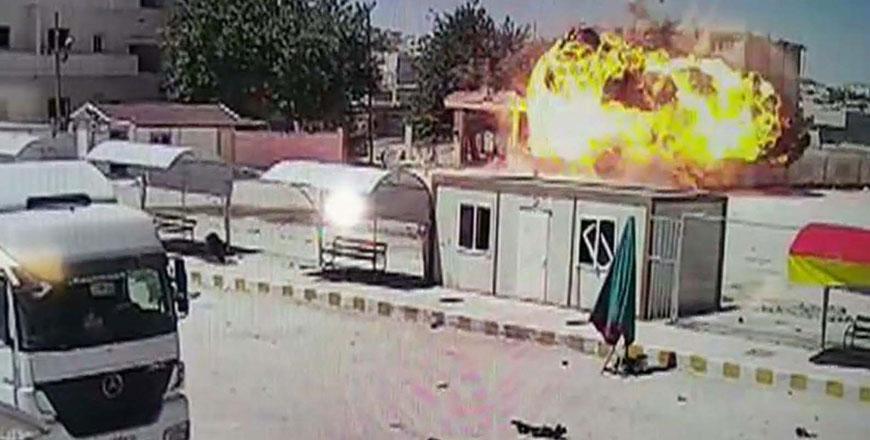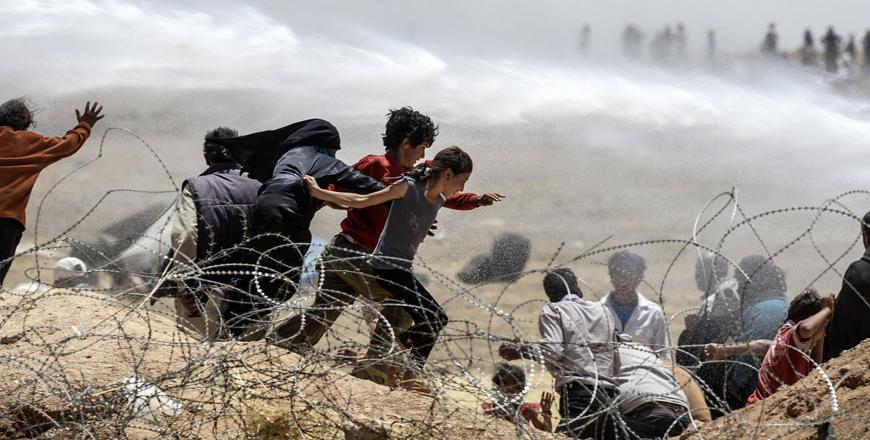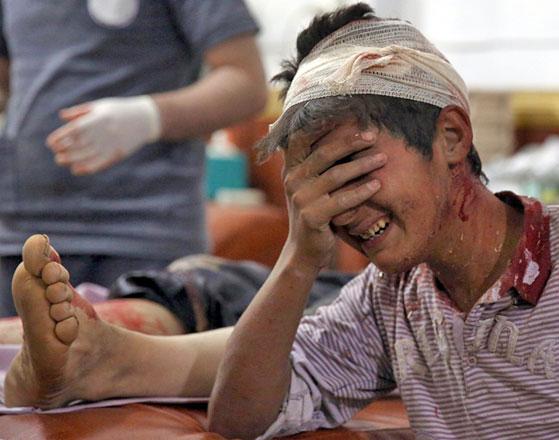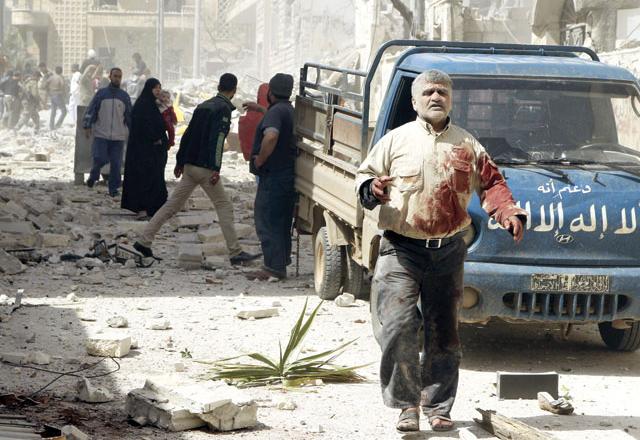You are here
Daesh attacks Syrian army and Kurds in twin assaults
By Reuters - Jun 25,2015 - Last updated at Jun 25,2015

xIn this still image taken from video made available on Thursday, an explosion is captured by a camera on the Turkish side of the border moments after a car bomb detonates in the Kurdish town of Kobani, Syria (Reuter)
BEIRUT — Daesh militants have launched simultaneous attacks against Syrian government and Kurdish militia forces, moving back onto the offensive after losing ground in recent days to Kurdish-led forces near the capital of their "caliphate".
Daesh sought to retake the initiative with incursions into the Kurdish-held town of Kobani at the Turkish border and government-held areas of Hasaka city in the northeast.
In a separate offensive in the multi-sided Syrian civil war, an alliance of rebels in the south of the country also launched an attack with the aim of driving government forces from the city of Daraa.
The attacks by Daesh follow a rapid advance by Kurdish-led forces deep into the hardline group's territory, to within 50km of its de facto capital Raqqa.
The dual assaults on government forces in Hasaka and Daraa, both provincial capitals, are a test of Assad's resolve to hold out in remote outposts beyond the western part of the country that is seen as the top priority for his survival.
The United States and European and Arab allies have been bombing Daesh since last year to try to defeat a group that a year ago proclaimed a caliphate to rule over all Muslims from territory in Syria and Iraq.
Daesh advanced rapidly last month, seizing cities in Syria and Iraq. The latest Kurdish advance in Syria has shifted the momentum again, but Daesh fighters have often adopted a tactic of advancing elsewhere when they lose ground.
The group said it had seized Al Nashwa district and neighbouring areas in the southwest of Hasaka, a city divided into zones of government and Kurdish control. Government forces had withdrawn towards the city centre, it said in a statement.
Syrian state TV said Daesh was expelling residents from their homes in Al Nashwa, executing people and detaining them. Many Daesh fighters had been killed, it said, included a commander identified as a Tunisian.
It also said a car bomb had exploded in the southeast of Hasaka.
Last government footholds
The Syrian Observatory for Human Rights, which tracks the war, said Daesh had seized two districts from government control.
Government-held parts of Hasaka are one of President Bashar Assad’s last footholds in the northeast region bordering Iraq and Turkey, territory mainly run by Kurds since Syria’s conflict erupted in 2011.
The Daesh attack on Kobani, also known as Ayn Al Arab, began with at least one car bomb in an area near the border crossing with Turkey, Kurdish officials and the observatory said. Daesh fighters were battling Kurdish forces in the town itself.
Kobani was the site of one of the biggest battles against Daesh last year. The Kurdish forces, known as the YPG, drove the Daesh militants back from Kobani with the help of US air strikes, after four months of fighting and siege.
YPG spokesman Redur Xelil said Thursday’s attackers had entered the town from the west in five cars, flying the flag of the Western-backed Free Syrian Army movement, which has fought alongside the YPG against Daesh.
“They opened fire randomly on everyone they found,” he told Reuters. The observatory said the attackers also wore YPG uniforms. Pictures posted on social media showed at least one dead man in uniform who was said to be an Daesh fighter.
The observatory said least 35 people, most of them civilians, were killed in the attacks, as well as 20 or more Kurdish civilians in a village south of Kobani. A YPG Facebook page said at least 15 Daesh fighters had been killed.
A doctor in the town, Welat Omer, said 15 people had been killed and 70 wounded, many of them seriously. Some had lost limbs and some of the wounded had been taken to Turkey.
Around 50 people fled to the Mursitpinar border gate after the attack, seeking to enter Turkey, local witnesses said. Syrian state TV said the attackers had entered Kobani from Turkey — a claim denied by the Turkish government.
Air strikes
US-led forces carried out air strikes on Thursday against Daesh in Hasaka and near the town of Tel Abyad, further west along the border with Turkey.
A Syrian official, speaking on condition of anonymity because he was not authorised to speak to the media, said Daesh appeared to be trying to divert enemy forces putting pressure on Raqqa: “I believe this is why they moved to Hasaka because they felt great danger from the situation in Raqqa.”
The Kurdish forces say they currently have no plan to march on Raqqa city.
In Syria’s south, rebels launched an assault to capture Daraa, which, if it falls, would be the third provincial capital lost by Assad in the four-year-long war, after Raqqa and Idlib, which is held by another rebel alliance.
The Syrian government has lost ground since March in the northwest, the south and the centre, where Palmyra fell to Daeshlast month.
Assad’s control is now mainly confined to the major population centres of western Syria, where he has sought to tighten his grip with the help of Lebanon’s Hezbollah Shiite militia, his main allies.
An alliance of rebel groups known as the “Southern Front”, which profess a secular vision for Syria, said its Daraa offensive had begun at dawn. Al Qaeda-linked Al Nusra Front also has a presence in the south.
“If the battle takes time, we are prepared. We have begun the preparatory shelling but we cannot assess the situation right now,” said Issam Al Rayyes, spokesman for the Southern Front.
Khaled Al Hanous, governor of Daraa province, told state TV the insurgents had launched “a real war with intensified shelling with various weapons or artillery on citizens in the neighbourhoods of the city and on hospitals, schools and infrastructure”.
The rebels had not made “one metre of progress”, he said.
Related Articles
BEIRUT — The Syrian Kurdish YPG militia said it began an advance towards a Daesh-held town at the Turkish border on Saturday, thrusting deep
BEIRUT — A Syrian Kurdish militia said it had recovered full control of the border town of Tel Abyad on Wednesday after Daesh militants raid
Daesh is preparing for a possible attack on a city in northeastern Syria near the border with Iraq where it remains a big threat despite recent setbacks, a Kurdish official told Reuters on Tuesday.














